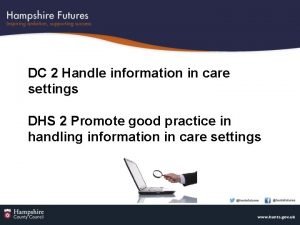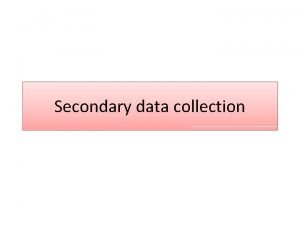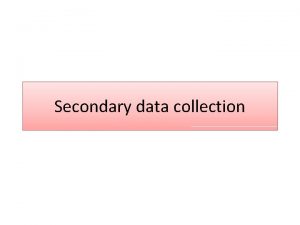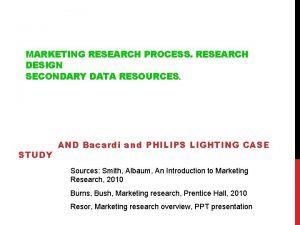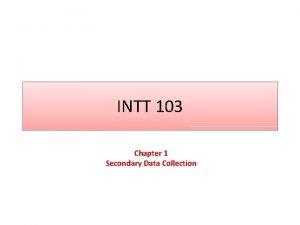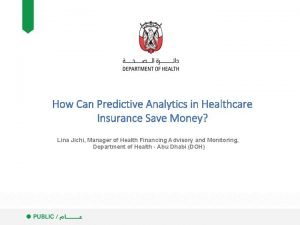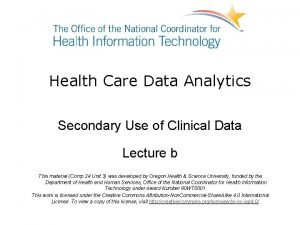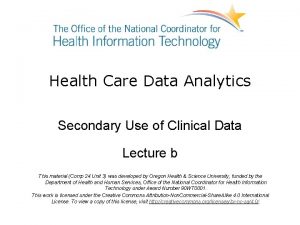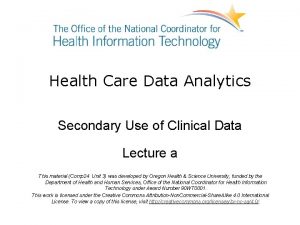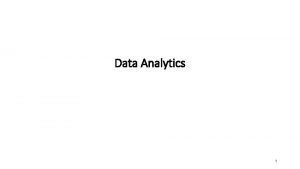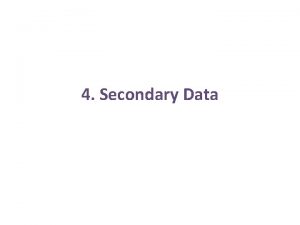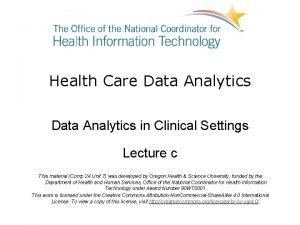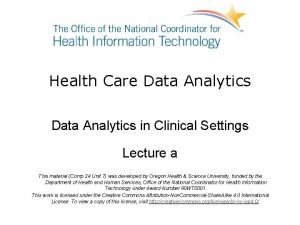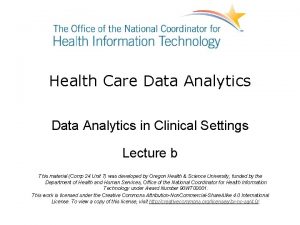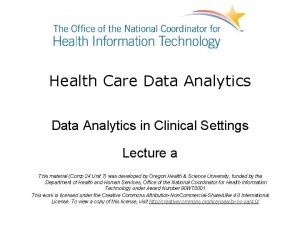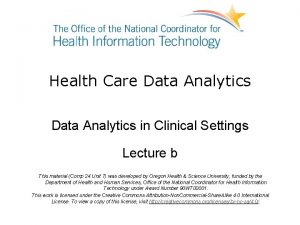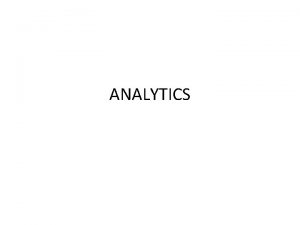Health Care Data Analytics Secondary Use of Clinical

















- Slides: 17

Health Care Data Analytics Secondary Use of Clinical Data Lecture a This material (Comp 24 Unit 3) was developed by Oregon Health & Science University, funded by the Department of Health and Human Services, Office of the National Coordinator for Health Information Technology under Award Number 90 WT 0001. This work is licensed under the Creative Commons Attribution-Non. Commercial-Share. Alike 4. 0 International License. To view a copy of this license, visit http: //creativecommons. org/licenses/by-nc-sa/4. 0/.

Secondary Use of Clinical Data Learning Objectives • Describe the secondary uses of clinical data, including EHRs (Lecture a) • Discuss the limitations and challenges of re-using clinical data (Lecture b) • Conduct a data re-use analysis for health care quality measurement utilizing a sample data set 2

Opportunities for Secondary Use • Using data to improve health care delivery • Health care quality measurement and improvement • Clinical and translational research • Public health surveillance • Implementing the learning health system 3

Using Data to Improve Health Care • Shift of payment from “volume to value” – Organizations need to manage information better • Predictive analytics – Use of data to anticipate poor outcomes or increased resource use – Applied to problem of early hospital re-admission • A requirement for “precision medicine” 4

Quality Measurement and Improvement • Quality measures increasingly used to make care more “accountable” • Some quality measures found to lead to improved patient outcomes but not in others • Desire is to derive automatically from EHR data, but has proven challenging 5

Clinical and Translational Research - 1 • Activities of NIH Clinical and Translational Science Award (CTSA) Program – Helped many institution develop clinical data repositories • e. MERGE Network – Associate genotypes and phenotypes – http: //emerge. mc. vanderbilt. edu – Uses EHR data to identify genomic variants associated with a number of diseases 6

Clinical and Translational Research - 2 • Other successes include replication of clinical studies – Randomized controlled trials o Women’s Health Initiative o Other cardiovascular diseases and value of statin drugs in primary prevention of coronary heart disease – Observational studies o Metformin and reduced cancer mortality rate 7

Public Health • Syndromic surveillance – Aims to use data sources for early detection of public health threats – Interest increased after 9/11 attacks • Ongoing effort in Google Flu Trends – https: //research. googleblog. com/2015/08/the-next -chapter-for-flu-trends. html – Search terms entered into Google predicted flu activity but not early enough to intervene – Performance in recent years has been poorer 8

Implementing the Learning Health System (ONC, 2014) 9

Secondary Use of Clinical Data Summary – Lecture a • The are many potential secondary uses or re-uses of clinical data, especially that from the EHR • Such data can be used to improve care delivery. quality measurement and improvement, clinical and translational research, and public health surveillance • This may all come together to implement the learning health system 10

Secondary Use of Clinical Data References – 1 – Lecture a References Amarasingham, R. , Patel, P. , Toto, K. , Nelson, L. , Swanson, T. , Moore, B. , . . . Halm, E. (2013). Allocating scarce resources in real-time to reduce heart failure readmissions: a prospective, controlled study. BMJ Quality & Safety, 22, 998 -1005. Anonymous. (2011). Toward Precision Medicine: Building a Knowledge Network for Biomedical Research and a New Taxonomy of Disease. Washington, DC: National Academies Press. Anonymous. (2014). Connecting Health and Care for the Nation: A 10 -Year Vision to Achieve an Interoperable Health IT Infrastructure. Retrieved from Washington, DC: http: //www. healthit. gov/sites/default/files/ONC 10 year. Interoperability. Concept. Paper. pdf Barkhuysen, P. , de. Grauw, W. , Akkermans, R. , Donkers, J. , Schers, H. , & Biermans, M. (2014). Is the quality of data in an electronic medical record sufficient for assessing the quality of primary care? Journal of the American Medical Informatics Association, 21, 692 -698. Burwell, S. (2015). Setting value-based payment goals - HHS efforts to improve U. S. health care. New England Journal of Medicine, 372, 897 -899. Butler, D. (2013). When Google got flu wrong. Nature, 494, 155 -156. 11

Secondary Use of Clinical Data References – 2 – Lecture a References Chapman, W. , Christensen, L. , Wagner, M. , Haug, P. , Ivanov, O. , Dowling, J. , & Olszewski, R. (2004). Classifying free-text triage chief complaints into syndromic categories with natural language processing. Artificial Intelligence in Medicine, 33, 3140. Collins, F. , & Varmus, H. (2015). A new initiative on precision medicine. New England Journal of Medicine, 372, 793 -795. Danaei, G. , Rodríguez, L. , Cantero, O. , Logan, R. , & Hernán, M. (2011). Observational data for comparative effectiveness research: An emulation of randomised trials of statins and primary prevention of coronary heart disease. Statistical Methods in Medical Research, 22, 70 -96. Gerbier, S. , Yarovaya, O. , Gicquel, Q. , Millet, A. , Smaldore, V. , Pagliaroli, V. , . . . Metzger, M. (2011). Evaluation of natural language processing from emergency department computerized medical records for intra-hospital syndromic surveillance. BMC Medical Informatics & Decision Making, 11, 50. Gildersleeve, R. , & Cooper, P. (2013). Development of an automated, real time surveillance tool for predicting readmissions at a community hospital. Applied Clinical Informatics, 4, 153 -169. 12

Secondary Use of Clinical Data References – 3 – Lecture a References Ginsberg, J. , Mohebbi, M. , Patel, R. , Brammer, L. , Smolinski, M. , & Brilliant, L. (2009). Detecting influenza epidemics using search engine query data. Nature, 457, 10121014. Gottesman, O. , Kuivaniemi, H. , Tromp, G. , Faucett, W. , Li, R. , Ritchie, M. , . . . Williams, M. (2013). The Electronic Medical Records and Genomics (e. MERGE) Network: past, present, and future. Genetics in Medicine, 15, 761 -771. Hebert, C. , Shivade, C. , Foraker, R. , Wasserman, J. , Roth, C. , Mekhjian, H. , . . . Embi, P. (2014). Diagnosis-specific readmission risk prediction using electronic health data: a retrospective cohort study. BMC Medical Informatics & Decision Making, 14, 65. Henning, K. (2004). What is syndromic surveillance? Morbidity and Mortality Weekly Report, 53(Suppl), 5 -11. Jha, A. , Joynt, K. , Orav, E. , & Epstein, A. (2012). The long-term effect of Premier pay for performance on patient outcomes. New England Journal of Medicine, 366, 1606 -1615. Mac. Kenzie, S. , Wyatt, M. , Schuff, R. , Tenenbaum, J. , & Anderson, N. (2012). Practices and perspectives on building integrated data repositories: results from a 2010 CTSA survey. Journal of the American Medical Informatics Association, 19(e 1), e 119 -e 124. 13

Secondary Use of Clinical Data References – 4 – Lecture a References Newton, K. , Peissig, P. , Kho, A. , Bielinski, S. , Berg, R. , Choudhary, V. , . . . Denny, J. (2013). Validation of electronic medical record-based phenotyping algorithms: results and lessons learned from the e. MERGE network. Journal of the American Medical Informatics Association, 20(e 1), e 147 -154. Parsons, A. , Mc. Cullough, C. , Wang, J. , & Shih, S. (2012). Validity of electronic health record-derived quality measurement for performance monitoring. Journal of the American Medical Informatics Association, 19, 604 -609. Pathak, J. , Bailey, K. , Beebe, C. , Bethard, S. , Carrell, D. , Chen, P. , . . . Chute, C. (2013). Normalization and standardization of electronic health records for high-throughput phenotyping: the SHARPn consortium. Journal of the American Medical Informatics Association, 20, e 341 -e 348. Safran, C. , Bloomrosen, M. , Hammond, W. , Labkoff, S. , Markel-Fox, S. , Tang, P. , & Detmer, D. (2007). Toward a national framework for the secondary use of health data: an American Medical Informatics Association white paper. Journal of the American Medical Informatics Association, 14, 1 -9. 14

Secondary Use of Clinical Data References – 5 – Lecture a References Tannen, R. , Weiner, M. , & Xie, D. (2008). Replicated studies of two randomized trials of angiotensin-converting enzyme inhibitors: further empiric validation of the 'prior event rate ratio' to adjust for unmeasured confounding by indication. Pharmacoepidemiology and Drug Safety, 17, 671 -685. Tannen, R. , Weiner, M. , & Xie, D. (2009). Use of primary care electronic medical record database in drug efficacy research on cardiovascular outcomes: comparison of database and randomised controlled trial findings. British Medical Journal, 338, b 81. Tannen, R. , Weiner, M. , Xie, D. , & Barnhart, K. (2007). A simulation using data from a primary care practice database closely replicated the Women's Health Initiative trial. Journal of Clinical Epidemiology, 60, 686 -695. Wang, T. , Dai, D. , Hernandez, A. , Bhatt, D. , Heidenreich, P. , Fonarow, G. , & Peterson, E. (2011). The importance of consistent, high-quality acute myocardial infarction and heart failure care results from the American Heart Association's Get with the Guidelines Program. Journal of the American College of Cardiology, 58, 637 -644. 15

Secondary Use of Clinical Data References – 6 – Lecture a References Weiner, M. , Barnhart, K. , Xie, D. , & Tannen, R. (2008). Hormone therapy and coronary heart disease in young women. Menopause, 15, 86 -93. Xu, H. , Aldrich, M. , Chen, Q. , Liu, H. , Peterson, N. , Dai, Q. , . . . Denny, J. (2014). Validating drug repurposing signals using electronic health records: a case study of metformin associated with reduced cancer mortality. Journal of the American Medical Informatics Association, Epub ahead of print. 16

Health Care Data Analytics Secondary Use of Clinical Data Lecture a This material was developed by Oregon Health & Science University, funded by the Department of Health and Human Services, Office of the National Coordinator for Health Information Technology under Award Number 90 WT 0001. 17
 Primary secondary tertiary care definition
Primary secondary tertiary care definition Hip fracture care clinical care standard
Hip fracture care clinical care standard Teramond
Teramond Health and social care unit 2
Health and social care unit 2 Health and social component 3
Health and social component 3 Data protection act in health and social care settings
Data protection act in health and social care settings Syndicated sources of data are
Syndicated sources of data are Data collection secondary data sources
Data collection secondary data sources Data quality is always a concern with secondary data
Data quality is always a concern with secondary data Primary data and secondary data
Primary data and secondary data Secondary data
Secondary data Primary data collection
Primary data collection Example of secondary data
Example of secondary data Primary data and secondary data
Primary data and secondary data Interval scale example in research
Interval scale example in research Midas healthcare solutions inc
Midas healthcare solutions inc Micromedex
Micromedex Predictive analytics in health insurance
Predictive analytics in health insurance





